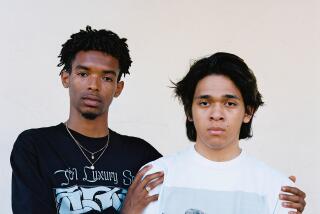Printer Discovers the Key to Making Maps on Cloth : Manufacturing: Textile printing experts told the entrepreneur it couldn’t be done, so he found a way, and his business prospered.
- Share via
GRASS VALLEY, Calif. — The key to Rick McEwan’s growing cloth-printing business is precision: His topographical maps on bandannas are just as legible as their counterparts on paper.
His firm, Visual Dialogues, has also printed a photograph on T-shirts that only dragster specialists would appreciate: The photo shows a car accelerating so abruptly that its front wheels are off the ground. And on the rear tire, you can see the stress ripples in the sidewall more clearly than in a glazed-paper poser from the same photograph.
Now McEwan is negotiating with a New York publishing company that says it has always been told by the textile-printing industry that map-quality precision couldn’t be achieved on cloth.
But McEwan does it, defying the experts who said it couldn’t be done.
Why should maps be on cloth?
As defense against wind and rain, backpackers and other outdoor enthusiasts love them.
And why would anyone want tire sidewall ripples on T-shirts?
For advertising aimed at auto buffs, traditionally more vulnerable to a well-turned-out T-shirt than to a printed poster.
McEwan achieves his precision with screen printing. That’s not the same as the method used in most T-shirt shops, where designs are printed before the customer’s very eyes. The latter is a heat transfer, sticking color to cloth. It fades with washing.
Screen printing puts ink into the fabric. It lasts.
Each screen deposits tiny dots. At Visual Dialogues they are mostly 110 to 133 dots per inch. The dots go into the most tightly woven fabrics McEwan can find, although some dots inevitably land in the voids where the threads aren’t. Visual Dialogues is working on 150 per inch for a new line of maps on cloth.
The Screen Printing Assn. International says few textile screen printers venture beyond 65 dots per inch, but McEwan says 85 is fairly common.
Last year, Visual Dialogues printed more than 20,000 mostly six-color trademarked Bandanamaps Its three dozen designs are mostly topographical maps of national parks, with a few cities such as San Francisco.
The T-shirts showing the tire sidewall were a black and white custom job for an automobile company.
Visual Dialogues also has a line of artistic or decorative--if not poetic--patterns with names such as “Powder Skier” and “Touch the Earth.”
McEwan printed his first Bandanamap three years ago at his Grass Valley home. A graduate of San Francisco Art Institute with a master’s degree from San Francisco State University, McEwan experimented with painting, drawing, silk screening and photography. He won the first prize for photography at the 1983 California State Fair.
“I wanted a useful map, not just a souvenir,” he said during a recent tour of the plant. But equipment and materials fell short. “I would call up the makers and they would say I was asking for the impossible. I just came to the conclusion not to listen to anyone.”
“I rebuilt the press. I altered the ink. I modified everything. I pulled a lot of hair out--so to speak--while doing it. . . . I don’t feel there are any obstacles, only opportunities.”
As the 2,400-square-foot plant into which Visual Dialogues moved last June, McEwan demonstrates.
His two silk screen presses look like whirligigs, each consisting of six bandanna-sized frames sticking outward and upward from spokes on a hub.
He spreads a bandanna on a horizontal platen and reaches up for a frame whose bottom is covered with a tightly stretched polyester screen. It harbors a gob of unctuous yellow ink.
The screen comes down flat on the bandanna. Grabbing a squeegee, McEwan forces yellow ink through the screen into the bandanna. He raises the frame back to storage position, rotates the whirligig to the red-ink frame and brings it down to a precise fit. The key word is “precise.”
The image emerges as McEwan repeats the process through all the colors.
McEwan says sales rose from about $80,000 in 1988 to $150,000 in 1989, “and I can see that doubling again.”
Bandanamaps sell for around $7 each in national park gift shops and sports stores. Mail-order prices range from $4.95 to $7.95 for bandannas and $8.50 to $13.95 for T-shirts--long- and short-sleeved--and up to $18.95 for a sleep shirt.
More to Read
Inside the business of entertainment
The Wide Shot brings you news, analysis and insights on everything from streaming wars to production — and what it all means for the future.
You may occasionally receive promotional content from the Los Angeles Times.










